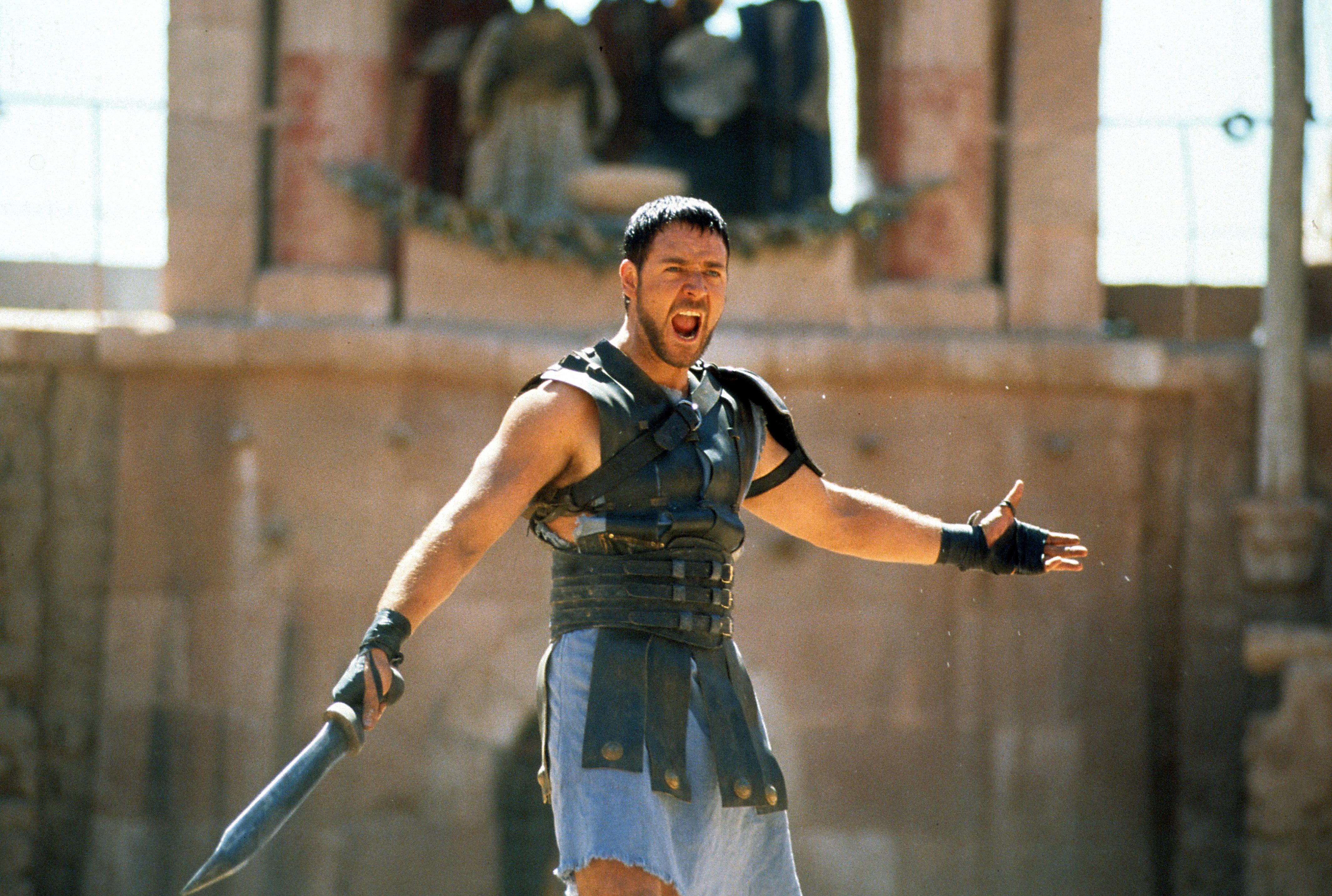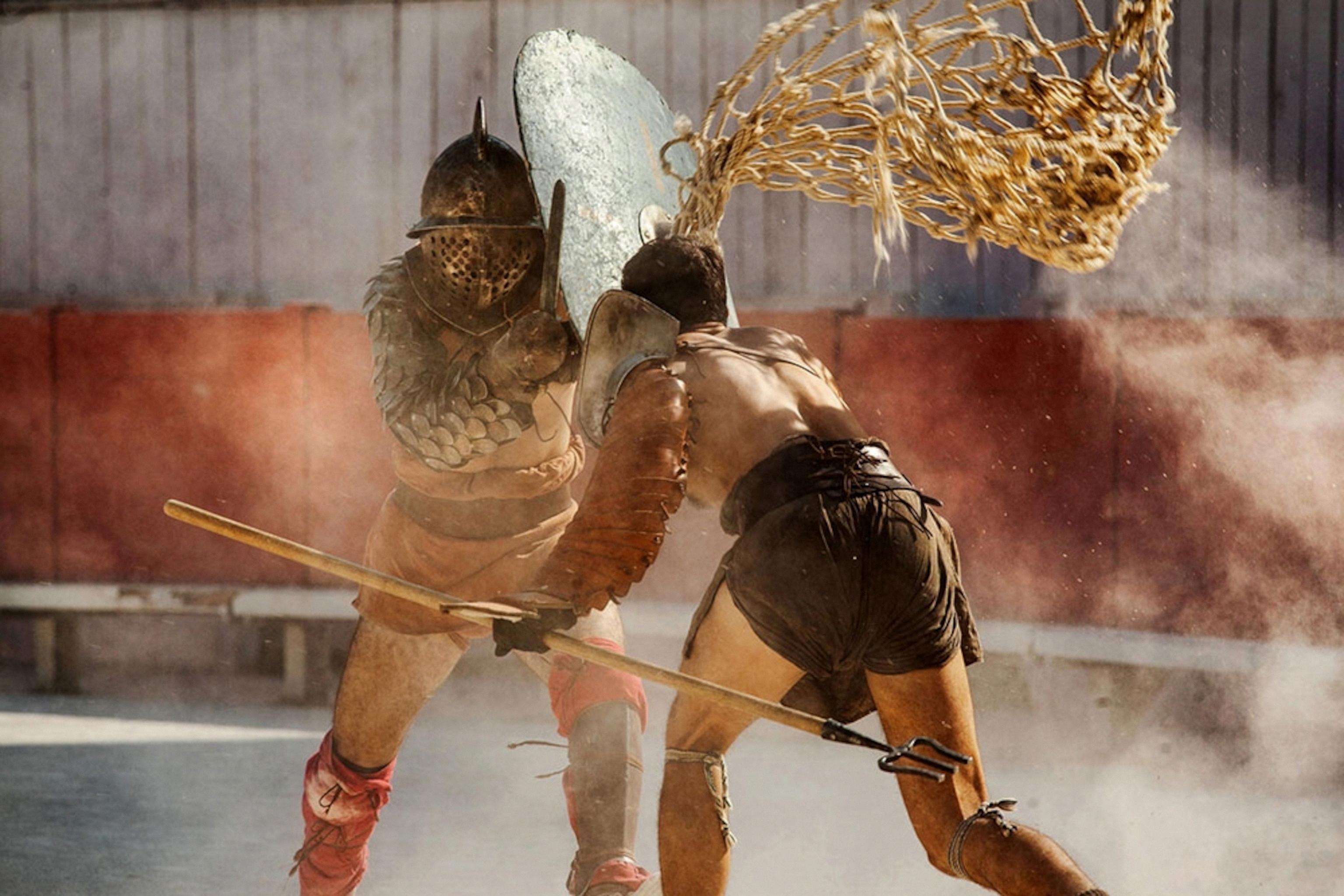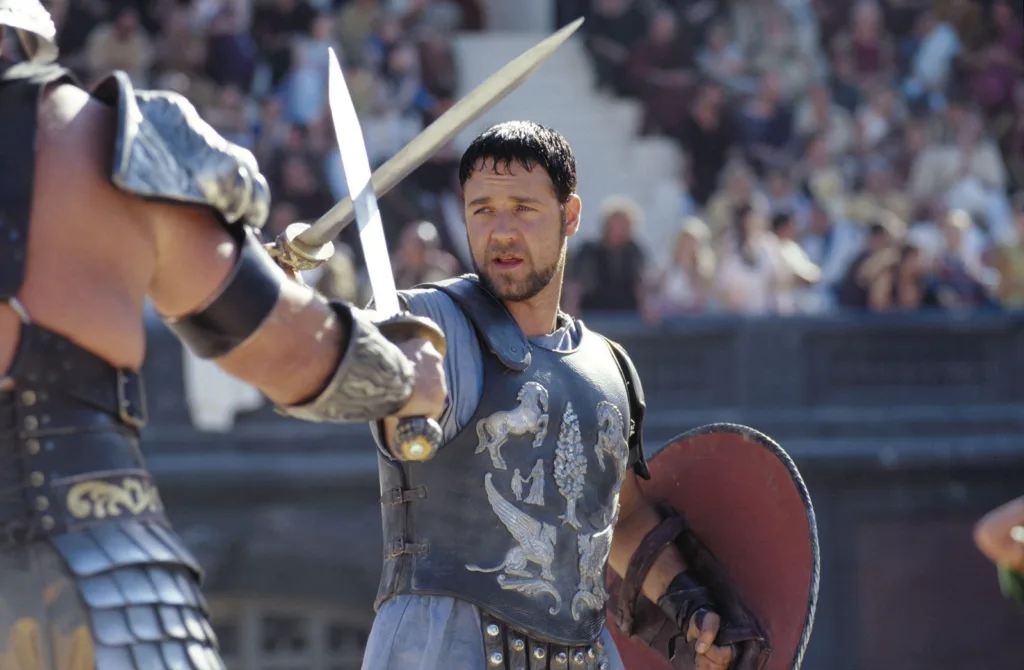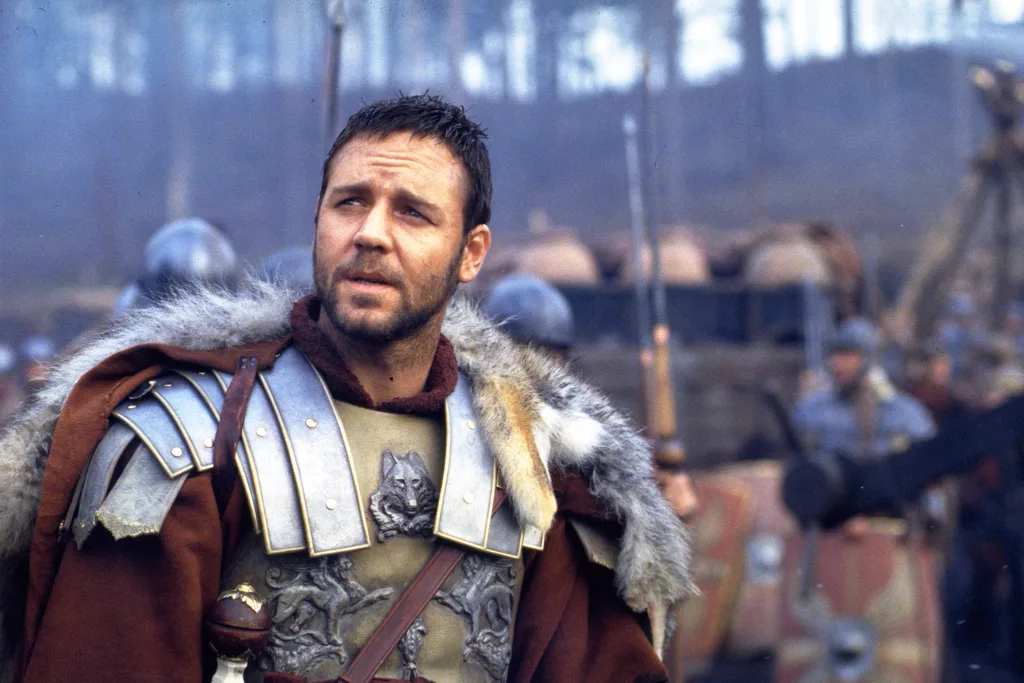The 2000 film Gladiator, directed by Ridley Scott, is a masterpiece of cinematic storytelling. Loosely based on real events that occurred within the Roman Empire in the latter half of the 2nd century AD, the film tells the story of Maximus Decimus Meridius, a fictitious character who seems as if he could be a composite of actual historical figures.
Although Maximus did not exist, the film’s historical advisors ensured that Roman culture was portrayed more accurately than in any previous film. Despite this effort, however, the film’s historical accuracy is highly questionable.
To better understand the truth behind Gladiator, let’s take a closer look at some of its key elements.
Maximus Decimus Meridius is a Roman general who becomes a gladiator after being betrayed and sold into slavery. Although he is a fictitious character, he seems to embody the virtues of a typical Roman soldier. Maximus is stoic, brave, and fiercely loyal to his emperor and his men.
While Maximus did not exist, he may have been inspired by the historical figure of Marcus Nonius Macrinus. Like Maximus, Marcus was a general who was well-known and liked by the emperor. Unlike Maximus, however, Marcus did not become a gladiator.
The film takes place during the reign of Marcus Aurelius, a real-life emperor who ruled from 161 to 180 AD. Known for his philosophical writings and military campaigns, Marcus was a complex figure who sought to reform the Roman Empire.
In the film, Marcus is portrayed as a wise and benevolent ruler who wishes to pass his power to Maximus instead of his own son, Commodus. While it is true that Marcus had a complicated relationship with Commodus, the film’s portrayal of Marcus as a model emperor is not entirely accurate.
Commodus, played by Joaquin Phoenix, is the main antagonist of the film. He is portrayed as a power-hungry and unstable ruler who is willing to do whatever it takes to maintain his grip on the throne.
While Commodus was a real-life emperor who ruled from 180 to 192 AD, the film’s portrayal of him is highly exaggerated. In reality, Commodus was not a particularly successful ruler, but he was not the cartoonish villain that the film makes him out to be.
The film’s portrayal of gladiatorial combat is one of its most iconic and memorable elements. While the film takes some liberties with the rules and customs of gladiatorial combat, it is generally accurate in its depiction of the brutality and spectacle of these events.
Gladiators were typically slaves or prisoners of war who were forced to fight for the entertainment of the Roman people. While some gladiators were highly trained professionals, others were amateurs who were thrown into the arena for the amusement of the crowd.
Gladiator is a stunning work of art that captures the imagination and transports the viewer to a world of ancient Rome. While the film’s historical accuracy is not perfect, it succeeds in creating a compelling narrative that draws on real-life events and characters to create a vivid and memorable story.
Whether you are a fan of historical epics or action-packed adventure films, Gladiator is an experience that shoud not be missed.
Is ‘Gladiators’ Based on a True Story?
Gladiator, the epic historical drama film directed by Ridley Scott, is loosely based on real events that occurred in the Roman Empire in the latter half of the 2nd century AD. The main character, Maximus Decimus Meridius, is a fictional character, but many of the supporting characters and events depicted in the film have historical roots.
To ensure historical authenticity, Ridley Scott hired several historians as advisors for the film. They provided valuable insights into Roman culture and society, including the political climate, military tactics, and social hierarchy.
While Gladiator takes artistic liberties with some of the historical details, it does an excellent job of portraying ancient Rome’s grandeur, decadence, and brutality. The film’s depiction of gladiatorial combat, in particular, is highly accurate, thanks to extensive research and consultation with experts.
Some of the real events that inspired Gladiator include the reign of Emperor Commodus, who ruled from 180 to 192 AD, and the rise of the Praetorian Guard, the elite soldiers who served as the emperor’s personal bodyguards. The film also touches on the decline of the Roman Republic and the rise of the Roman Empire, as well as the struggles of the gladiators themselves, who were often slaves or prisoners forced to fight for ther lives.
While Gladiator is not a completely accurate portrayal of historical events, it does offer a compelling glimpse into ancient Rome’s politics, culture, and social dynamics.

Source: npr.org
Was Maximus from ‘Gladiator’ a Real Person?
Maximus Decimus Meridius, the protagonist of the 2000 film Gladiator, was a fictional character created for the movie. Although the character was not a real historical figure, he was portrayed as a skilled Roman general who served under the emperor Marcus Aurelius.
It is important to note that while Maximus was not a real person, the film’s creators drew inspiration from various historical figures to create his character. For example, some historians have suggested that Maximus was based on the real-life Roman general and politician Maximus of Hispania, who lived during the 4th century AD.
Despite the fictional nature of the character, Maximus has become an iconic figure in popular culture and has inspired countless films, TV shows, and books. His story of revenge, redemption, and loyalty has resonated with audiences around the world and has cemented his place in cinematic history.
While Maximus Decimus Meridius was not a real person, his character was inspired by various historical figures and has left a lasting impact on popular culture.
The Real-Life Gladiator: Who Was It?
The real-life gladiator that inspired the character of Maximus Decimus Meridius in the 2000 film Gladiator was Marcus Nonius Macrinus. Macrinus was a Roman general who served in the army during the reign of Emperor Marcus Aurelius. He was a close friend of the emperor and was even named as one of his personal legates.
Marcus Nonius Macrinus was born in Rome in the year 164 AD. He joined the Roman army and quickly rose through the ranks, eventually becoming a general. He fought in several battles and was known for his bravery and leadership skills.
During his time in the army, Macrinus became a close friend of Emperor Marcus Aurelius. The two men shared a love of philosophy and often discussed their beliefs and ideas. Macrinus was even named as one of the emperor’s personal legates, which gave him a great deal of influence and power within the Roman Empire.
After the death of Marcus Aurelius, Macrinus became a consul and continued to serve in the army. He was eventually appointed as the governor of Syria, where he served for several years beore retiring from public life.
Although Macrinus was not a gladiator, his life served as the inspiration for the character of Maximus Decimus Meridius in the film Gladiator. Both men lived during the same time period and were close friends of Marcus Aurelius. Like Maximus, Macrinus was known for his bravery, leadership skills, and loyalty to the emperor.
Factual Accuracy of the Movie ‘Gladiator’
Gladiator, the epic film directed by Ridley Scott, is a masterpiece of cinematic storytelling. The movie’s vivid characters, breathtaking action, and stunning visuals have captivated audiences worldwide sine its release in 2000. However, when it comes to historical accuracy, the film falls short in several areas.
First and foremost, Gladiator’s portrayal of the Roman Empire’s political climate is not entirely accurate. The movie depicts Commodus, the son of Emperor Marcus Aurelius, as a power-hungry tyrant who seizes control of the empire. In reality, Commodus was not as incompetent as he is depicted in the film. He ruled for over a decade and was responsible for several significant reforms, including the expansion of the Roman citizenship to all free-born men.
Another significant inaccuracy in Gladiator is the depiction of gladiatorial combat. While the film accurately portrays the brutality of the sport, it fails to represent the intricate rules and customs surrounding gladiatorial combat. For example, the movie shows gladiators fighting to the death, while in reality, most fights ended with one fighter being disarmed or knocked to the ground. Moreover, the film shows gladiators fighting in the Colosseum, which wasn’t built until after Commodus’s reign.
Additionally, Gladiator’s portrayal of Roman society is not entirely accurate. The film depicts a society where slavery is commonplace, and slaves are treated inhumanely. While slavery was prevalent in ancient Rome, it was not as pervasive as the film suggests. Moreover, the movie fails to acknowledge the significant role that women played in Roman society. Women held positions of authority and were involved in political and social activities.
Gladiator is a brilliant film that captures the essence of ancient Rome’s culture and history. However, it is not entirely accurate in its portrayal of the Roman Empire’s political climate, gladiatorial combat, and society. While the movie’s artistic merit cannot be denied, it is essential to separate fact from fiction when analyzing its historical accuracy.
The Deadliest Gladiator in History
The title of the deadliest gladiator in history is a contested one, as there were many skilled fighters who participated in the Roman games. However, there are a few gladiators who stand out as particularly deadly.
One of thse gladiators was known as “the Gaul,” or sometimes “the Gallic gladiator.” He was a member of the Samnite class of gladiators, which meant that he fought with a short sword and a large rectangular shield. The Gaul was known for his agility and his ability to use his shield not only for defense, but also as a weapon.
Another deadly gladiator was the murmillo, who was armed with a gladius (a short sword) and a large, oblong shield. The murmillo was often pitted against the thraex, a gladiator who fought with a curved sword and a small shield. The murmillo’s armor was designed to look like that of a Roman legionary, with a helmet that resembled a fish.
There was the retiarius, a gladiator who fought with a trident and a net. The retiarius was often pitted against the secutor, a gladiator who wore a helmet with a rounded top, designed to resemble the head of a fish. The retiarius’ net was used to ensnare the secutor, while the trident was used to deliver a killing blow.
While there is no one gladiator who can definitively be called the deadliest in history, the Gaul, murmillo, and retiarius are all contenders for the title. Each of these gladiators had a unique set of skills and weapons that made them deadly opponents in the arena.

Source: nationalgeographic.com
The Reality of Gladiator Death Matches
Gladiatorial contests were a popular form of entertainment in ancient Rome. While it is a common misconception that gladiators always fought to the death, in reality, this was not always the case.
Typically, gladiatorial contests involved single combat between two men of similar size and experience. These contests were overseen by referees who were responsible for ensuring that the fight was conducted fairly and that neither participant was seriousy injured.
If a gladiator was seriously wounded during a fight, it is likely that the referee would have stopped the contest. This was done in order to prevent the gladiator from being killed and to ensure that the crowd remained entertained.
While it is true that some gladiators did fight to the death, these instances were relatively rare. In most cases, gladiators were highly skilled fighters who were trained to put on an entertaining show for the crowd without causing serious harm to their opponents.
While gladiators did fight one another in contests, they did not always fight to the death. Referees oversaw the action and probably stopped the fight as soon as one of the participants was seriously wounded.
Are Tigers in Gladiator Real?
Gladiator, the acclaimed historical drama film, features a sequence where tigers make an appearance. The question arises as to whether these tigers were real or not. The answer is that the tigers in Gladiator were a combination of real tigers and a prosthetic tiger.
To create some of the shots in the sequence, real tigers were used. These tigers were filmed againt a bluescreen and later composited by Mill Film to appear closer to the characters. However, these shots were mainly ‘near misses’ where the tigers did not interact directly with the actors.
For the shots where the tigers interacted with the characters, a prosthetic tiger was utilized. This allowed for a more controlled environment and ensured the safety of the actors. The prosthetic tiger was particularly used for the shot where it launches on top of Maximus.
The tigers in Gladiator were a combination of real tigers and a prosthetic tiger. The use of real tigers was limited to shots where they did not directly interact with the actors, while a prosthetic tiger was used for the shots that required interaction.
Was Commodus a Historical Figure?
Commodus was a real person who lived during the Roman Empire. He was born on August 31, 161 CE in Lanuvium, Latium (now Lanuvio, Italy) and died on December 31, 192 CE. Commodus was the son of Marcus Aurelius, who was also a Roman emperor, and Faustina the Younger. He became emperor in 177 CE, and ruled jointly with his father until Marcus Aurelius’ death in 180 CE, after which he became sole emperor.
Commodus’ reign was marked by controversy and instability. He was known for his extravagant lifestyle and his love of gladiatorial games, which he ofen participated in himself. He was also accused of being mentally unstable and paranoid, and his reign was marked by political intrigue and assassination attempts.
Despite his controversial reign, Commodus was a real historical figure and played a significant role in the history of the Roman Empire. His life and reign have been the subject of numerous books, films, and other works of art, and continue to be a source of fascination for historians and the general public alike.
The Accuracy of the Story in ‘Gladiator’
Gladiator is a movie that is based on historical events and characters, but it is not a true story. The film takes place during the reign of Emperor Marcus Aurelius, who ruled the Roman Empire from 161 to 180 AD. Most of the characters in the movie, including Maximus, are fictional, although there are some historical figures depicted, such as Commodus, Lucilla, and Marcus Aurelius himself.
While the movie does draw on some historical events and customs, many of the details are inaccurate. For example, the gladiator battles depicted in the film are not entirely accurate, as they were often more complex and varied than what is shown onscreen. Additionally, the portrayal of Commodus as a bloodthirsty tyrant is not entirely accurate, as he was actually a relatively popular emperor for much of his reign.
Despite these inaccuracies, Gladiator remains a popular and entertaining movie that offers a glimpse into ancient Roman history and culture. For tose interested in learning more about the historical events and figures depicted in the film, there are many resources available, such as history books, documentaries, and online resources.
To summarize, while Gladiator is based on historical events and characters, it is not a true story and takes many liberties with the facts. However, it remains an entertaining and informative film that offers a glimpse into ancient Rome and its customs.

Number of Gladiators Killed
The Colosseum is one of the most iconic structures in Rome and was the site of numerous gladiatorial battles. Gladiators were trained fighters who would battle each other or wild animals for the entertainment of the Roman citizens. These battles were incredibly dangerous and often resulted in the death of one or more of the participants.
According to experts, around 400,000 gladiators were killed in the Colosseum alone. This number is staggering and gives us a glimpse into the brutal nature of the gladiatorial battles that took place in ancient Rome. These battles were often fought to the death, and the gladiators who participated knew that they were taking teir lives into their own hands.
It’s important to note that not all gladiators who fought in the Colosseum were slaves or prisoners. Some were free men who chose to fight in these battles for fame and fortune. However, regardless of their background, all gladiators who entered the Colosseum faced the same risks and dangers.
While the number of gladiators who died in the Colosseum is shocking, it’s important to remember that these battles were a significant part of Roman culture and history. Today, the Colosseum stands as a testament to the past and a reminder of the sacrifices that were made in the name of entertainment.
The Enduring Legacy of Gladiators
Gladiators, the ancient Roman fighters who entertained the masses in the Colosseum, do not exist in the same form as they did in ancient times. Today, gladiator games are not fought to the death, and there are no longer any spectators cheering on the fighters. However, gladiator-like competitions still exist in some parts of the world.
In modern times, gladiator games have evolved into economic games. Instead of fighting with swords, sandals, chariots, and shields, gladiators now compete in various sports and athletic events. These events are often televised and attract large audiences, who bet on the outcome of the competitions.
One example of a modern-day gladiator competition is mixed martial arts (MMA). MMA fighters train in various fighting styles, including boxing, wrestling, and Brazilian Jiu-Jitsu, and then compete in a ring or octagon. While the fights are not to the death, they can be brutal and often result in serious injuries.
Another example of a modern-day gladiator competition is professional wrestling. While the matches are scripted and the outcomes are predetermined, the wrestlers still engage in physical combat in the ring, often using chairs, tables, and other props to inflict damage on their opponents.
While gladiators no longer exist in the same form as they did in ancient times, gladiator-like competitions still exist in modern times. These competitions have evolved into economic games, where athletes compete in various sports and athletic events for the entertainment of audiences around the world.
Did Gladiators Win Their Freedom?
Some gladiators did win their freedom. It was not an easy feat, as gladiators were usually slaves or prisoners of war who were forced to fight for entertainment. However, some were able to earn their freedom trough exceptional performance in the arena or through the patronage of a wealthy sponsor.
To win their freedom, a gladiator had to receive a wooden sword, called a rudis, from their owner or sponsor. This symbolized their release from the gladiator profession and their return to free status.
One such famous gladiator who won his freedom was Flamma, a Syrian-born fighter who rose to fame during the reign of Emperor Hadrian. Flamma was awarded his freedom four times, but he repeatedly turned it down, choosing to continue fighting in the arena instead.
Other gladiators who won their freedom include Carpophorus, a popular fighter who was granted his freedom after winning over 20 battles, and Spiculus, a favorite of Emperor Nero who was given his freedom and a large estate as a reward for his success.
It’s important to note that while some gladiators were able to win their freedom, the vast majority were not so lucky. Many died in the arena or were killed by their opponents, and those who survived often remained enslaved for the rest of their lives.
Did Gladiators Fight Animals?
Gladiators did fight animals in some instances. The use of animals in gladiatorial contests was known as venationes or “wild beast hunts.” These contests involved pitting hungry animals against each other, or against gladiators. The animals used in these contests varied and included bears, rhinos, tigers, elephants, and even giraffes.
The gladiators often used metal gloves to increase their cutting power and cause bleeding. The use of these gloves made the fights more gruesome and exciting for the spectators. The animals were often starved to make them more aggressive and willing to fight.
It’s worth noting that not all gladiatorial contests involved animals. Many were simply gladiator vs. gladiator battles, with dfferent types of gladiators facing off against each other. However, the use of animals in these contests was a popular spectacle that drew large crowds.
While not all gladiatorial contests involved animals, the use of animals in these contests was a common practice in ancient Rome.

Banning of Gladiator Fights
Gladiatorial games were a popular form of entertainment in ancient Rome, where trained fighters battled each other to the death in front of a cheering crowd. The question of who banned these games is one that has been debated by scholars for many years.
The official answer is that Emperor Constantine prohibited gladiatorial games in AD 325, as stated in the Theodosian Code, XV. 12. However, it is widely believed that the ban was not fully enforced and that gladiatorial games continued in some form or another util AD 404.
It was Emperor Honorius who finally abolished munera altogether in AD 399, ordering the remaining schools to be closed. Theodoret, in his Ecclesiastical History, V, states that it was the Christian church’s influence that prompted Honorius to take this action.
Despite the ban, the memory of gladiatorial games lived on in popular culture, and the legacy of these brutal spectacles can still be seen in modern-day depictions of ancient Rome.
The Location of Commodus’ Stabbing of Maximus
In the movie “Gladiator,” Commodus stabs Maximus in the back just below the shoulder. The stabbing occurs after Commodus hugs Maximus and then kisses him. The wound is concealed by putting Maximus’ armor on and hiding it. It is important to note that this scene is a pivotal moment in the story as it marks the beginning of the end for Maximus and sets the stage for the rest of the plot.
Conclusion
Gladiator is a film that has captured the hearts of audiences all over the world. With its epic battles, stunning cinematography, and memorable characters, it is no surprise that it has become a classic of the genre. However, when it comes to historical accuracy, the film falls short in many ways.
While the film is loosely based on real events, the character of Maximus Decimus Meridius is entirely fictitious. This is not necessarily a bad thing, as creating a composite character can be an effective way to tell a story. However, the film takes liberties with the history of the Roman Empire that are hard to ignore.
One of the biggest issues with the film is its portrayal of Commodus, the son of Marcus Aurelius. In the film, Commodus is depicted as a power-hungry, sadistic tyrant who murders his own father to gain the throne. In reality, Commodus was not nealy as evil as he is portrayed in the film. While he was certainly not a great emperor, he was not the bloodthirsty monster that the film makes him out to be.
Despite its historical inaccuracies, Gladiator is still a great film. It tells a compelling story, and the performances of the cast are outstanding. However, it is important to remember that it is a work of fiction, and should not be taken as a historically accurate portrayal of the Roman Empire.
Gladiator is a film that has captivated audiences for years, but it is not a true story. While it is based on real events, the film takes many liberties with history that are hard to ignore. Despite this, it remains a classic of the genre, and a testament to the power of storytelling.
